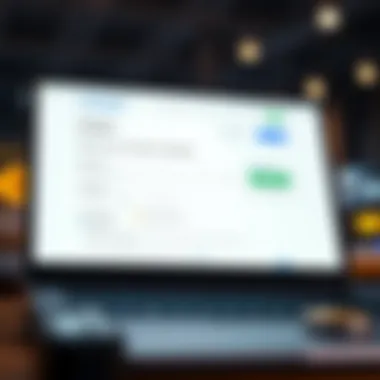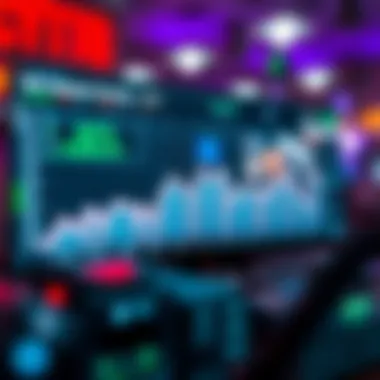A Complete Guide to Purchasing NFTs on Coinbase


Intro
In today's digital era, the rise of non-fungible tokens, or NFTs, has captivated the attention of investors, creators, and tech enthusiasts alike. While the concept of digital assets may seem complex, buying NFTs can be a straightforward process, especially using platforms like Coinbase. However, before one can jump into the NFT marketplace, it's crucial to grasp the foundational elements of cryptocurrency and the technologies that underpin these digital collectibles.
Understanding how cryptocurrency functions, alongside its close cousin, blockchain technology, sets the stage for a successful venture into the world of NFTs. Whether you're looking to invest in unique pieces of digital art or secure virtual real estate, a solid grasp of the environment you're navigating will greatly inform your decisions and strategies.
In this guide, we will explore various key points: understanding cryptocurrencies, their technology, investment strategies, managing risks, and best practices to follow when purchasing NFTs on Coinbase. Each section aims to illuminate the intricacies of the process and equip you with the necessary tools to make informed choices. So, let's embark on this enlightening journey into NFTs and explore how Coinbase serves as an accessible entry point for many enthusiasts.
Understanding Non-Fungible Tokens
Diving into the realm of non-fungible tokens, often abbreviated as NFTs, is crucial for anyone venturing into digital assets or the broader scope of blockchain technology. NFTs represent ownership of unique items or content within a digital space; they’re not interchangeable like currency or commodities. With this uniqueness comes certain imperatives for buyers, creators, and investors—understanding how they function could very well pave the way for informed decision-making in this astoundingly dynamic market.
Definition and Characteristics
To grasp the essence of NFTs, it’s necessary to define them. Non-fungible tokens are digital certificates saved on a blockchain that verify the ownership of a specific asset. Think of them as digital collectibles. While traditional cryptocurrencies like Bitcoin can be swapped freely with one another, each NFT stands apart, possessing distinct information that makes it irreplaceable.
Here are some characteristics that differentiate NFTs:
- Uniqueness: Each NFT has a unique identification and attributes that set it apart.
- Ownership: Ownership of an NFT is verifiable through its blockchain history, ensuring authenticity.
- Interoperability: Many NFTs are created on similar standards, allowing them to be used across different platforms and marketplaces.
- Divisibility: Unlike cryptocurrencies, NFTs cannot be divided into smaller units. Buying or selling an NFT happens only in whole units.
These characteristics not only showcase the innovative technology behind NFTs but also clarify why they hold value in particular sectors, especially art and collectibles. The potential for creators to sell their works directly to consumers, bypassing traditional distribution, adds another layer to the conversation.
The Role of NFTs in Digital Art and Culture
Once considered a niche domain, NFTs now play an integral role in the digital art world. These tokens have revolutionized how artists and creators interact with their audience, providing a new income stream in an ever-evolving cultural landscape. The proliferation of digital art, ranging from unique works to collectibles, now finds a home in the marketplace enabled by NFTs.
Artists have begun leveraging these tokens to:
- Gain Financial Control: By issuing their own NFTs, creators can gain revenue directly through sales without intermediaries.
- Establish Provenance: NFT technology allows artists to prove authenticity and ownership of their work, shielding them from plagiarism.
- Create Community: By using platforms that sell and exhibit their NFTs, artists forge connections with their audience, often increasing engagement and support.
Moreover, cultural institutions and organizations have jumped onto the NFT bandwagon, exploring how these tokens can be used to enhance engagement. Whether it’s a museum offering unique digital replicas or musicians releasing exclusive tracks, the possibilities are vast. As the landscape continues to evolve, keeping a finger on the pulse of NFT trends becomes essential for any serious observer in the digital space.
"NFTs have opened doors that many artists didn't even know existed. The ability to sell direct and control my work is liberating."
— An emerging digital artist.
In summary, understanding non-fungible tokens sheds light on a vital aspect of today’s digital ecosystem. Awareness of their properties and implications—especially in the context of digital art—equips individuals with the insight needed to navigate this landscape confidently.
Overview of Coinbase
In the realm of cryptocurrency and digital assets, Coinbase offers a robust platform that aids both novices and veteran users in navigating the complex world of blockchain technology. Understanding Coinbase is crucial for anyone looking to venture into the buying and selling of NFTs. With its interface and features designed to simplify the often overwhelming landscape of digital currencies, it makes a compelling case for itself as a preferred choice for purchasing NFTs.
Company Background
Founded in 2012, Coinbase started off as a simple wallet service for Bitcoin but has evolved tremendously since then. As of now, it operates in over 100 countries, providing a trusted environment for trading various cryptocurrencies and NFTs. This growth can be attributed to its commitment to security, regulatory compliance, and user-friendly experience.
Coinbase has opened the doors for many first-time investors and collectors by lowering the barriers to entry in the crypto space. Its emphasis on transparency and education has made it not just a platform for transactions but a full-fledged resource for information on blockchain technology and digital assets. For example, the Coinbase Earn program empowers users to learn about new coins while gaining a little crypto in exchange for their time and knowledge.
Core Features and Services
Coinbase provides a suite of features tailored to meet diverse user needs. A few key aspects of its service include:
- User-Friendly Interface: The clean design offers easy navigation, allowing even less tech-savvy individuals to execute trades without feeling lost.
- Coinbase Wallet: Users can store their cryptocurrencies securely, which is vital when it comes to purchasing NFTs that reside on the blockchain.
- Education Resources: Videos, tutorials, and articles guide users through the ins and outs of cryptocurrency, empowering them to make informed decisions about their investments.
- Advanced Trading Options: For those with a bit more experience, Coinbase Pro provides advanced trading features with lower fees, catering to the more serious trader.
- Staking and Earning: Users can earn additional rewards through staking and participating in various earning programs offered by the platform.
"Coinbase has become a cornerstone for those embarking on their cryptocurrency journey, serving as both a trading platform and a learning hub."
These features aren’t just perks; they reflect the platform’s strategic aim to be the go-to choice for anyone looking to smoothly transition into the NFT marketplace. By delivering clear advantages in terms of ease of use and access to resources, Coinbase stands out not only as a trading venue but as an essential partner in the evolving world of digital assets.
Creating a Coinbase Account
In the realm of digital currencies and non-fungible tokens, the first brick in the foundation is establishing a Coinbase account. This step is vital, as it acts as your gateway to the NFT world and simplifies the complexities of buying, selling, and storing digital assets. A Coinbase account not only introduces you to various cryptocurrencies but also paves the way for seamless transactions within the NFT marketplace. By creating an account, you unlock the ability to engage with a large array of NFTs, from digital artwork to collectible items.
Step-by-Step Registration Process


Getting started with Coinbase is straightforward, but knowing the steps can save you some headaches later on. Here’s a guide to registering:
- Visit the Coinbase website: Go to Coinbase.com.
- Click on ‘Get Started’: Look for the button that encourages you to start your account.
- Fill in your personal information: Enter your name, email address, and a secure password. Use a combination of letters, numbers, and special characters—this is your first line of defense against unauthorized access.
- Agree to the terms: It’s essential to read through the terms of service and privacy policy. Though they may be lengthy, they provide crucial information about your rights and Coinbase's responsibilities.
- Verify your email: Check your inbox for a verification email from Coinbase and click the link provided.
- Provide additional info: Coinbase will ask for your phone number, which is a key part of your security measures, and then you'll receive a verification code via SMS.
- Set up two-step verification: This is not just an extra precaution; it’s a necessity. Linking your account to an authenticator app or SMS ensures a significant layer of security.
- Complete your profile: Fill in personal details such as address and date of birth to ensure compliance with regulations.
Following these steps will ensure that you have a robustly set up account, ready to dive into the world of NFTs.
Verifying Your Identity
Once you've created your account, the next crucial step is identity verification. This process may feel a bit unwieldy, yet it's a regulatory requirement that serves to protect both the platform and its users. By confirming your identity, you not only comply with legal standards but also help to thwart potential fraud.
- Provide Documentation: To verify identity, you usually need to upload a government-issued ID. This could be a passport or driver’s license. It’s like showing your ID at a bar—you can't get in without it.
- Selfie Verification: In some cases, Coinbase may ask for a selfie to match with your ID. This ensures that the person creating the account is indeed who they say they are, catching any usual suspects who might try to masquerade.
- Wait for Confirmation: After submitting your documents, there’s typically a waiting period for the verification process. This can take anywhere from a few minutes to a few hours; patience is key here.
Having a verified account not only enhances your security but also expands your limits on transactions, allowing for a more flexible experience on the Coinbase platform. It’s a step that can’t be overlooked—think of it as your VIP badge to access premium digital spaces.
"A well-prepared account makes for a less bumpy ride in the chaotic world of digital assets."
Overall, creating and verifying your Coinbase account forms the bedrock upon which all your NFT purchasing activities will stand. It's not the most exciting part of the process, but it’s undeniably essential.
Linking Your Wallet to Coinbase
When diving into the world of Non-Fungible Tokens (NFTs), compehending the significance of linking your wallet to Coinbase is paramount. In simple terms, your wallet acts as a digital passport, granting you the ability to store, receive, and send various cryptocurrency assets, including NFTs. Without linking a suitable wallet, navigating the vast marketplace that Coinbase offers becomes somewhat like driving a car without having wheels. Your experience can be limited and frustrating if you're not prepared.
Choosing the Right Wallet
The decision regarding which wallet to utilize is crucial. There are many wallets available, each with distinct features tailored to different needs. Some popular options include MetaMask, Coinbase Wallet and Trust Wallet. Factors to consider when selecting a wallet include:
- Security Features: Look for wallets that have strong security protocols; two-factor authentication is a wise feature to seek.
- User Experience: A wallet with an intuitive interface can save you time and headaches, especially if you're new to the scene.
- Compatibility: Ensure that your chosen wallet works smoothly with Coinbase and supports the specific NFTs you’re interested in.
- Control Over Private Keys: Ideally, pick a wallet that lets you hold your private keys. Not keeping private keys means your control over assets is somewhat diminished.
If you're a beginner, a user-friendly wallet like Coinbase Wallet might be your best bet. It not only offers ease of use but integrates seamlessly with the Coinbase platform, giving you access to your crypto assets without unnecessary hurdles.
Step-by-Step Wallet Integration
Now that you've chosen a wallet, linking it to your Coinbase account is the next big step. Here is a simple guide to help you navigate this process:
- Open Your Coinbase Account: If you haven't already, sign into your Coinbase account.
- Access Wallet Settings: Go to your account settings and look for the wallet integration section.
- Select Your Wallet Type: Depending on the wallet you've chosen, select from the options provided.
- Follow the Prompts: Coinbase will direct you through a guided process. The app may ask for information such as wallet address or public key to establish a connection.
- Confirm the Connection: After inputting the necessary info, confirm the integration. You may receive a notification or email verifying that your wallet is linked successfully.
- Test the Functionality: Consider sending a small transaction to ensure everything works smoothly. This step checks whether your wallet can interact with your Coinbase account without any complications.
Remember: Always keep your wallet software updated and remain vigilant against phishing attempts. Be sure to treat your digital assets with utmost caution.
Linking your wallet to Coinbase is an essential step in participating in the NFT market. With a secure wallet linked, you can dive deeper into buying, selling, and enjoying digital art and collectibles with peace of mind, knowing your assets are safe and accessible.
Exploring the NFT Marketplace on Coinbase
Diving into the NFT marketplace on Coinbase is a crucial aspect of becoming a savvy digital collector. This section not only equips you with the knowledge of how to navigate the platform but also highlights the benefits of understanding this unique marketplace. The world of NFTs is challenging to comprehend fully due to its rapid evolution and the broad variety of tokens available. It’s essential to know how Coinbase structures its marketplace, as this can simplify the purchasing process and enhance your overall experience.
The market on Coinbase offers a vast array of NFTs, ranging from digital art to collectibles and much more. By exploring this marketplace, buyers can find exclusive pieces or limited editions that resonate with their personal taste or investment strategy. Moreover, familiarity with the interface can significantly reduce the risk of mishaps, like buying something unintended or overpaying due to lack of knowledge.
Navigating the Marketplace Interface
The Coinbase NFT interface is designed to be user-friendly, which makes finding and purchasing NFTs straightforward even for beginners. Upon logging into your account, users are greeted with a clean dashboard that highlights various categories of NFTs.
- Homepage Features: The main page presents trending NFTs, featured artists, and collections, making it easier for you to discover what others are interested in.
- Search Functionality: There's a robust search tool. You can filter NFTs by different criteria such as price, categories, or collection names. It’s like having your own digital treasure map.
- Detailed View: When you click on an NFT, you can access a wealth of information, including ownership history, pricing trends, and artist details. This information is key in making informed purchasing decisions.
One of the standout features is the ability to view NFTs in a gallery format, providing a visual treat as you scroll through options. Each NFT page usually offers an option to "Watch" the item, enabling you to keep tabs on price changes or offers.
Finding Specific NFTs
Locating specific NFTs that catch your eye can seem daunting at first, given the overwhelming number available on the platform. However, there are strategies that can help streamline this process:
- Utilize the Search Bar: Enter the name of the artist, collection, or specific NFT. It’s a straightforward way to drill down directly to what interests you.
- Filters and Sort Options: Make use of existing filter features. You can sort by price range, popularity, or date listed. This function saves time and helps narrow down choices efficiently.
- Track Cryptocurrency Trends: Sometimes a specific NFT may gain value based on trends in the crypto market. Staying updated with sites like CoinMarketCap can provide context that influences your search.
- Engage with the Community: Forums like Reddit’s NFT subreddit can offer insights into popular NFTs or lesser-known gems that may not surface easily in search results.
Navigating the NFT marketplace on Coinbase is not just about finding and purchasing assets; it's about understanding the underlying trends and building a collection that reflects your interests and values. Whether you’re after a specific piece or simply browsing for inspiration, being proactive in your search can yield rewarding results.


Purchasing an NFT
When it comes to the realm of digital ownership, buying an NFT represents both an opportunity and a journey. This section aims to crystallize the notion of purchasing an NFT, explore the nuances of the process, and delineate the component parts involved.
NFTs can offer a unique value proposition for collectors, investors, and enthusiasts alike. What makes owning an NFT appealing is the embodiment of ownership within a blockchain framework, granting certified, immutable proof of purchase. However, understanding how to navigate the buying landscape is crucial for a successful transaction.
Here are several aspects you need to consider:
- Scarcity and Unique Value: Each NFT comes with its own unique identifier that distinguishes it from cryptos or other digital items. This means that owning an NFT is not simply about ownership; it’s about having something genuinely unique that can appreciate over time.
- Marketplaces and Their Dynamics: Each marketplace can have different rules and mechanisms for buying NFTs. Understanding the nuances, such as auction versus fixed-price listings, can greatly affect your purchasing strategy.
- Long-term Vision: When you purchase an NFT, think carefully about its potential long-term value. Many buyers focus on market trends, artistic relevance, or the creator's reputation.
As you step into this new world of digital art and assets, the next logical step is to wrap your head around the various pricing and auction models.
Understanding Pricing and Auction Models
The prices of NFTs can fluctuate significantly; this variability is largely due to market demand, rarity, and the overall interest in the creator or collection. Here are a few key points to consider when examining pricing:
- Fixed Price Listings: Just as it sounds, some sellers list their NFTs at a set price. In this scenario, the buyer need not engage in a bidding war and can purchase the asset directly, provided they have enough funds.
- Auction-style Sales: Many NFTs are sold via auctions, where potential buyers place bids within a specified timeframe. This competitive angle can drive prices up, particularly if the item generates buzz or interest. Generally, auction formats can be broken down into:
- Market Fluctuation: It's key to keep an eye on how trends and external factors, such as media visibility or endorsements by celebrities, can impact NFT prices. What may seem quiet one week could explode in demand the next.
- Gas Fees: When purchasing NFTs on platforms like Coinbase, buyers must also account for transaction costs, commonly referred to as gas fees, that can vary depending on network congestion.
- Ascending Auctions: where the price gradually increases until no more bids are made.
- Dutch Auctions: which start at a high price and decrease until someone purchases.
Understanding these pricing models can give you a strategic advantage. Know what you’re willing to spend and what might make a good investment for your portfolio.
Executing Your First Purchase
Once you’ve zeroed in on an NFT you want to acquire, executing the purchase is the next logical step. Here’s how to do it seamlessly:
- Ensure Your Wallet is Funded: Before executing your purchase, make sure your wallet has enough crypto, such as Ethereum, to cover the price of the NFT plus any applicable transaction fees.
- Select the NFT: Navigate to the listing, whether it’s a direct sale or an auction. Pay close attention to details like the description, creator, and ownership history. Conducting your due diligence is paramount.
- Confirm Your Purchase Method: If it’s an auction, you’ll need to place a bid. In the case of a fixed-price sale, simply click the purchase button. Follow the prompts carefully to ensure all fields are correctly filled.
- Transaction Confirmation: After you submit your payment, you should receive a confirmation. Depending on the platform’s network, it may take a few moments to process.
- Verifying Ownership: Once the purchase goes through, check your digital wallet. The NFT should appear in your collection, and you can verify ownership on the blockchain.
The excitement of acquiring an NFT lies not just in ownership but in the community and potential opportunities tied to it. Keep in mind that the NFT space can be volatile, so staying informed and adapting to changes will serve you well.
To sum up, navigating the world of NFTs through platforms such as Coinbase allows both novice and seasoned buyers a structured path toward exploring digital ownership's vast potential.
Marketplace Fees and Charges
Understanding the fees associated with buying NFTs on Coinbase is crucial to any investor or enthusiast's journey. When you dive into the world of digital assets, it’s essential to grasp not just the excitement of ownership, but also the costs that come along with those digital treasures. If you overlook the fees, you might find that your excitement starts to dwindle when more money goes out than you initially budgeted for.
The marketplace generally charges fees as a way to facilitate trades and maintain the platform. This might seem straightforward; however, diving deeper reveals a series of intricate components and considerations.
Breakdown of Transaction Fees
When it comes to purchasing NFTs, transaction fees can vary based on the type and value of the token as well as the selected payment method. Here’s a closer look:
- Buyer’s Fees: This is typically a percentage of the total purchase price, which covers Coinbase's costs for processing the transaction. It’s vital to know what this fee is before you initiate your buying processes.
- Gas Fees: If you’re buying NFTs on the Ethereum network, you will likely incur gas fees. These fees compensate miners for the computational work involved in confirming transactions on the blockchain. They can fluctuate wildly depending on network congestion.
- Seller’s Fees: If you’re dealing with a seller in a marketplace structure, sometimes sellers will pass on certain fees. It’s always wise to clarify who’s absorbing these costs, as that can impact the final price you're willing to pay.
As much as these fees might seem an unwelcome surprise, being informed helps you set a realistic budget. Here's a practical example of how transaction fees may influence your purchase:
- Imagine you find a stunning NFT priced at $200. If the platform charges a 2.5% transaction fee, that's an additional $5 you’re tacking onto your purchase.
- Now, if a gas fee of $10 is added at the moment of transaction due to high network demand, your total expense climbs to $215 just to buy that digital artwork.
Other Costs to Consider
Apart from the direct transaction fees, there are other associated costs that can sneak up on you during your NFT purchasing journey:
- Storage Fees: Depending on your wallet solution, some wallets charge a fee for maintaining your NFTs. Be sure to research what storage options come with additional costs.
- Withdrawal Fees: If you later decide to transfer your NFTs to a different wallet or platform, withdrawal fees may come into play. Knowing these upfront prepares you for any future transactions.
- Taxes: Always keep taxes in mind. In many jurisdictions, selling an NFT may incur capital gains tax, which could significantly affect your bottom line.
Here's an overview of how you might account for these costs:
- Transaction Fees: 2.5%
- Gas Fees: Varied
- Storage Fees: Monthly or annual rates, depending on service provider
- Withdrawal Fees: Platform-dependent
- Potential Tax Responsibilities
"Failing to account for fees when investing in NFTs could significantly impact your returns."
Being equipped with this knowledge helps enhance your purchasing experience. It’s like going to a store with a shopping list, knowing the price of each item rather than being blindsided at checkout. Plan well, invest wisely!


Security Considerations
In the world of non-fungible tokens, security is not just a luxury; it’s a necessity. Given the rise of NFTs, securing one's digital assets has become paramount. Cryptocurrency and NFTs are alluring, but they come with their share of risks, from cyber theft to market manipulation. Therefore, understanding security considerations can make a world of difference in safeguarding your investments.
Safeguarding Your Assets
When it comes to protecting your NFTs, there’s no one-size-fits-all approach. Here are some crucial steps you can take to ensure your digital assets are secure:
- Use Strong Passwords: Always opt for complex passwords that are not easy to guess. Consider combining letters, numbers, and special characters. Remember, weak passwords are often the first line of attack for scammers.
- Enable Two-Factor Authentication (2FA): Many platforms, including Coinbase, offer 2FA. By using it, you add an extra layer of security. This means even if someone gets hold of your password, they won’t easily access your account.
- Keep Your Private Keys Safe: Your private key is the crux of your wallet’s security. Store it in a secure place and do not share it with anyone. A misplaced or shared private key can cost you everything.
"The best way to protect your NFT is to treat it like a $100 bill. Don’t leave it lying around."
- Invest in a Hardware Wallet: For serious collectors, a hardware wallet is a smart choice. It keeps your assets offline, away from potential online threats. While it may involve an initial investment, the peace of mind it offers can be worth its weight in gold.
- Regular Backups: Don’t forget to back up your wallet regularly. This ensures that even if your device crashes, you can still regain access to your assets.
Recognizing Common Scams
With the boom in the NFT market, unfortunately, scams have proliferated. Being able to spot a fraudulent scheme can save both money and valuable assets. Here are some common scams to stay clear of:
- Phishing Emails: Scammers often impersonate legitimate companies, urging you to click on malicious links. Always inspect URLs and make sure you're logging in through the official site.
- Fake NFT Listings: Always double-check NFT listings for authenticity. Some fraudsters create fake profiles and listings to lure unsuspecting buyers.
- Too-Good-To-Be-True Offers: If an NFT is being sold at a price that makes your jaw drop, be suspicious. It might just be a bait. Authenticity and market valuations matter, and if something feels off, trust your instincts.
- Rug Pulls: Be cautious of projects that offer high rewards but lack transparency. Always research the developers and community backing any NFT project before investing your time and money.
By following these guidelines, you can take confident strides in your NFT journey. Keeping security at the forefront will ensure that your experience remains enjoyable and fruitful, without falling prey to common pitfalls.
Best Practices for NFT Buyers
When it comes to delving into the world of NFTs, adopting best practices isn’t just a matter of preference; it’s crucial for ensuring a smooth and secure buying experience. The right strategies can mean the difference between making informed purchases and falling prey to scammers or market volatility. This section highlights some essential practices that every NFT buyer should consider, providing a foundation that can lead to more successful investments and a richer understanding of the NFT ecosystem.
Researching NFTs Before Purchase
Before making a purchase, it’s important to dive deep into the specifics of any NFT you’re considering. This involves more than just looking at the eye-catching artwork or the hype surrounding a project. Researching NFTs effectively includes the following components:
- Artist Background: Look into the creator's past works and their reputation in the art or crypto communities. Verify if they have an established presence on platforms like Twitter, Instagram, or even dedicated NFT forums.
- Rarity and Utility: Every NFT has a level of rarity and, in some cases, a utility that affects its value. Investigate how many editions exist and whether the NFT has any additional features, such as access to exclusive events or memberships.
- Marketplace Dynamics: Different marketplaces have varying dynamics, with some being more reputable than others. Explore user reviews and community feedback on platforms like Reddit or social media to identify which marketplaces hold a trustworthy reputation.
- Historical Pricing: Track the pricing history of the NFT you’re interested in. This can provide valuable insights into past performance and help you understand potential future trends.
"Good research is like laying a solid foundation for a house; it keeps everything stable and sound."
Being thorough in your research will arm you with the knowledge necessary to make savvy purchases and avoid common pitfalls associated with the NFT market.
Diversifying Your Digital Assets
Diversification is a fundamental investment strategy that resonates across all asset classes, and NFTs are no exception. Instead of putting all your eggs into one basket, consider spreading your investments across various types of NFTs. Here are some strategies:
- Explore Different Genres: NFTs span various genres, from digital art and collectibles to game assets and virtual real estate. By investing in multiple genres, you can mitigate risks linked to a single market.
- Balance Risk and Reward: It’s wise to allocate parts of your investment to both high-risk and low-risk NFTs. While high-risk pieces can potentially yield more significant returns, stable projects can protect your capital.
- Be Mindful of Market Trends: Keep an eye on emerging trends within the NFT sphere. Certain areas may gain traction, such as utility-based NFTs or integration with virtual reality. Adapting your investment strategy to include these trends can provide an edge.
- Staying Flexible: The digital assets market can shift rapidly. Being ready to pivot your strategy, either to cash in on profitable NFTs or to minimize losses, requires a watchful eye and an adaptable mindset.
In the ever-evolving landscape of NFTs, a diversified portfolio isn’t just smart; it’s necessary for promoting longevity and resilience in your investments.
By implementing these best practices, NFT buyers can navigate the complexities of the market with greater ease, ensuring that they make informed decisions that are conducive to their individual investment goals.
The Future of NFTs and Coinbase
The landscape of non-fungible tokens (NFTs) is rapidly evolving, significantly impacting digital ownership and the overall art market. As platforms like Coinbase position themselves at the center of this revolution, understanding what lies ahead becomes crucial for investors, educators, enthusiasts, analysts, and developers alike. The future of NFTs and Coinbase is not just about buying or selling tokens; it’s about redefining the digital economy and creating a space where ownership, authenticity, and community engagement thrive.
The NFT market is anticipated to become a multi-billion dollar sector, with unprecedented growth driven by technology and consumer demand.
Market Trends and Predictions
Several market trends highlight the direction in which NFTs and platforms like Coinbase are heading. Firstly, the rise of fractional ownership is expected to gain traction. Investors can purchase a share of expensive NFTs, allowing a broader audience access to high-value art pieces or collectibles. Furthermore, the integration of virtual reality (VR) and augmented reality (AR) with NFTs is on the cusp of transformation. Imagine participating in a virtual gallery where you can interact with digital art in real-time. This synergy will likely foster not just trading but also a deeper appreciation and creative expression.
Additionally, the mainstream adoption of NFTs is unfolding as various sectors—such as music, gaming, and fashion—integrate these tokens into their ecosystems. Digital artists and musicians are embracing NFTs as new revenue streams, giving them more control over their creations and allowing fans to engage with their work on an entirely new level.
Innovations on the Horizon
Innovative solutions are coming to the forefront of the NFT market, transforming how transactions occur and assets are secured. One noteworthy innovation is layer-2 scaling solutions, which significantly enhance transaction speeds and reduce costs on the blockchain. This technology ensures that users don’t face prohibitive fees, allowing for smoother trading experiences on platforms like Coinbase.
Moreover, smart contracts are becoming more sophisticated. These self-executing contracts can automate various elements of transactions, enhancing security and trust among parties involved in the buying and selling of NFTs. For instance, a smart contract can automatically distribute royalties to artists each time their NFT is resold, ensuring that creators are compensated fairly throughout the life of their digital asset.
Another area of keen interest involves interoperability between blockchains. As the NFT landscape expands, we may witness a greater number of platforms working together, allowing these tokens to be traded across different environments. This could potentially lead to a more diverse marketplace where buyers and sellers enjoy increased flexibility and choice.
As Coinbase and similar platforms continue adapting and innovating, they play a pivotal role in shaping the future of NFTs, unlocking possibilities that blend art, technology, and commerce seamlessly.







